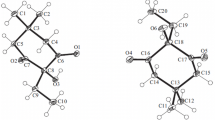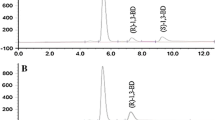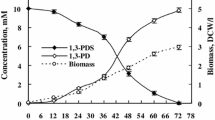Abstract
The prochiral sila-ketone acetyldimethyl-(phenyl)silane (1) was reduced enantioselectively into (R)-(1-hydroxyethyl)dimethyl(phenyl)silane [(R)-2] using resting cells of the commercially available yeast Saccharomyces cerevisiae (DHW S-3) as the biocatalyst. The bioconversion was performed on a 2.0-g scale in a 5-1 bioreactor. Starting with a substrate (1) concentration of 0.4 g·1−1, the highest production rate measured for this bioconversion was about 45–55 μmol (R)-2·1−1·min−1. After an incubation time of 1 h, all substrate in the medium had been converted, either biocatalytically reduced to (R)-2 or (probably chemically) converted into dimethyl(phenyl)silanol (Me2PhSiOH). After extraction of the cell-free medium with ethyl acetate/dichloromethane and subsequent purification of the extract by Kugelrohr distillation and chromatography on silica gel (medium-pressure liquid chromatography), 800 mg (yield 40%) of the bioconversion product (R)-2 was isolated. As shown by HPLC studies (cellulose triacetate as the chiral stationary phase) and 1H-nuclear magnetic resonance experiments (after derivatization of the bioconversion product with a chiral auxiliary agent), compound (R)-2 was almost enantiomerically pure (> 99% enantiomeric excess).
Similar content being viewed by others
References
Bergbreiter DE, Momongan M (1992) Asymmetric synthesis of organometallic reagents using enzymatic methods. Appl Biochem Biotechnol 32:55–72
Czuk R, Glänzer BI (1991) Baker's yeast mediated transformations in organic chemistry. Chem Rev 91:49–97
Fischer L (1994) Capacity of the yeast Trigonopsis variabilis (DSM 70714) for the enantioselective reduction of organosilicon compounds. Adv Mol Cell Biol, in press
Fischer L, Syldatk C, Wagner F (1990) A new enantioselective NAD(P)-dependent oxidoreductase from Trigonopsis variabilis (DSM 70714). Ann NY Acad Sci 613:614–617
Fukui T, Zong M-H, Kawamoto T, Tanaka A (1992) Kinetic resolution of organosilicon compounds by stereoselective dehydrogenation with horse liver alcohol dehydrogenase. Appl Microbiol Biotechnol 38:209–213
Ryabov AD (1991) The biochemical reactions of organometallics with enzymes and proteins. Angew Chem Int Ed Engl 30:931–941
Sonomoto K, Oiki H, Kato Y (1992) Enzymatic conversion of artificial organosilicon compounds by alcohol dehydrogenase. Enzyme Microbiol Technol 14:640–643
Syldatk C, Andree H, Stoffregen A, Wagner F, Stumpf B, Ernst L, Zilch H, Tacke R (1987) Enantioselective reduction of acetyldimethylphenylsilane by Trigonopsis variabilis (DSM 70714). Appl Microbiol Biotechnol 27:152–158
Syldatk C, Stoffregen A, Wuttke F, Tacke R (1988) Enantioselective reduction of acetyldimethylphenylsilane: a screening with thirty strains of microorganisms. Biotechnol Lett 10:731–736
Tacke R, Becker B (1987) Sila-substitution of drugs and biotransformation of organosilicon compounds. Main Group Met Chem 10:169–197
Tacke R, Linoh H (1989) Bioorganosilicon chemistry. In: Patai S, Rappoport Z (eds) The chemistry of organic silicon compounds, part 2. Wiley, Chichester, pp 1143–1206
Tacke R, Zilch H, Stumpf B, Ernst L, Schomburg D (1987) Synthese optisch aktiver Silicium-Verbindungen mittels enantioselektiver mikrobieller Transformationen. In: Chemie-Dozententagung 1985. VCH, Weinheim, p 67
Tacke R, Wagner SA, Brakmann S, Wuttke F, Eilert U, Fischer L, Syldatk C (1993) Synthesis of acetyldimethyl(phenyl)silane and its enantioselective conversion into (R)-(1-hydroxyethyl)dimethyl-(phenyl)silane by plant cell suspension cultures of Symphytum officinale L. and Ruta graveolens L. J Organomet Chem 458:13–17
Zilch H, Tacke R (1986) Fluorid-induzierte Fragmentierung von Acetyldimethylphenylsilan. J Organomet Chem 316:243–247
Zong M-H, Fukui T, Kawamoto T, Tanaka A (1991) Bioconversion of organosilicon compounds by horse liver alcohol dehydrogenase: the role of the silicon atom in enzymatic reactions. Appl Microbiol Biotechnol 36:40–43
Author information
Authors and Affiliations
Additional information
This article is dedicated to Prof. Dr. Fritz Wagner on the occasion of his 65th birthday
Rights and permissions
About this article
Cite this article
Fischer, L., Wagner, S.A. & Tacke, R. Preparation of enantiomerically pure (R)-(1-hydroxyethyl)dimethyl(phenyl)silane using resting cells of Saccharomyces cerevisiae (DHW S-3) as biocatalyst. Appl Microbiol Biotechnol 42, 671–674 (1995). https://doi.org/10.1007/BF00171942
Received:
Accepted:
Issue Date:
DOI: https://doi.org/10.1007/BF00171942




